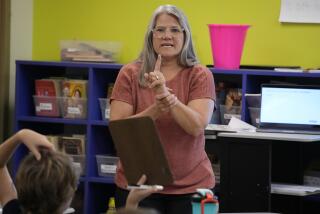Video Stories Stir Pupils’ Interest in Math
- Share via
NASHVILLE, Tenn. — The sound of a gunshot leads Jasper Woodbury to a wounded bald eagle in a video adventure series that teachers believe is making math enthusiasts out of fifth- and sixth-graders.
“You know who the person is and have a reason to want to solve the problem,” said 12-year-old John Overton, whose class used the four video math programs at Carter Lawrence Middle School.
The video disc program, which can be coupled with computers, is being tested at 16 schools in nine states. It is among an explosion of systems integrating technology into the classroom to improve learning and spur interest.
MaryAn Whitlow, a teacher from El Dorado, Ark., noticed early on that “very, very weak students got just as involved as those really bright students.”
“It’s everyday situations that could really happen to them, and they can visualize it, they can identify with it,” she said.
Ken Komoski, executive director of EPIE, or Education Produces Information Exchange, in Hampton Bays, N.Y., said there were 900 such systems in 1983, when his company began surveying.
“Now, there are over 12,000 on our database, and about one-fourth of those are in math. Most teachers haven’t any idea of what the range of those options are,” Komoski said.
Komoski and John Bransford, a researcher at the Learning Technology Center at Vanderbilt University who helped create “The Adventures of Jasper Woodbury,” said video interests children.
“There’s no question that good use of a full-motion video or tape can be very motivating,” Komoski said.
In the Jasper series, students watch stories in which the characters are faced with problems such as getting the bald eagle to a veterinarian or organizing a recycling project.
They must not only solve the mathematical problems but figure out what the problems are.
For instance, in one, Emily needs to know how much weight she will be carrying, what the headwinds will be and how much fuel she will need to pick up the eagle in an ultralight plane.
“Most word problems are ridiculously arbitrary, they pose situations that make no sense,” Bransford said. Jasper’s creators, he said, tried to pose problems with characters whom pupils will like.
Early tests found that students who used the Jasper series doubled their success at solving problems they had to set up or plan themselves, while other students at the same schools basically stayed the same.
But the creators caution that data is sketchy and they are still studying the effects.
Samuel Y. Gibbon Jr., one of the original producers of “Sesame Street,” said technology makes it easier to show children how math applies to the world.
“Learning math independent of real world problems is a pointless exercise. That’s why math has been such a difficult thing to teach and learn,” he said. “It would be better if you could make a field trip, but that presents huge problems with logistics and liability.”
Gibbon said that one “revolution” in teaching math has come through computer software that lets a student write out an equation and see it graphically represented instantly, then change it and see a simultaneous change in the graph.
“The general effect of the more interesting technology is that the emphasis is shifted from teaching to learning,” said Gibbon, now a program officer for the Sloan Foundation in New York.
He said the first thing that happens with any new technology is that it is applied to old purposes, replacing paper, pencil and blackboard. But improvements in software and experience are moving classrooms in new directions, he said.
The biggest mistake that has been made in introducing technology is lack of teacher training, Komoski, Gibbon and Bransford agreed.
“Teachers’ lives are impossibly crowded as they are, and training presents a huge problem,” Gibbon said. “They need to be given time, and that means money.”
More to Read
Sign up for Essential California
The most important California stories and recommendations in your inbox every morning.
You may occasionally receive promotional content from the Los Angeles Times.













